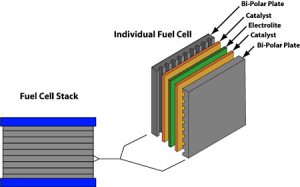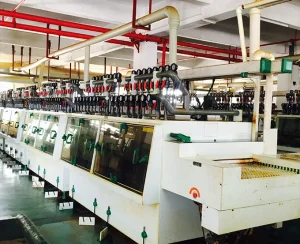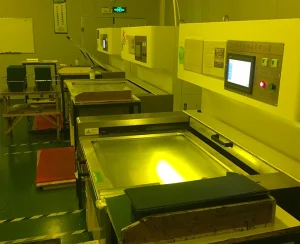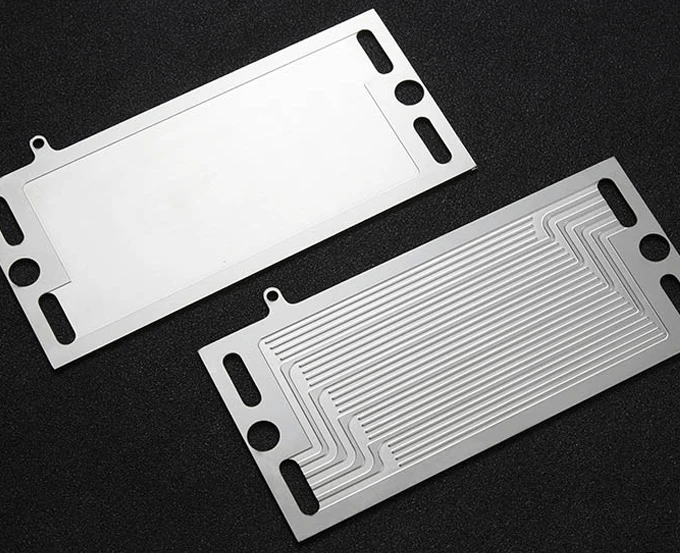It is very important to avoid scratches in the flow channels and ensure flow channel in the production of bipolar plates. Bipolar plates play crucial roles in fluid distribution and electrical connectivity, which are essential to the operation of fuel cells and water electrolyzes. to ensure their quality, particularly in terms of avoiding scratches and keeping uniform flow channels. This article explores management strategies for these problems and emphasizes the value of best practices and modern manufacturing processes.
What are bipolar plates?
Bipolar plates are a main component in a fuel cell stack. A bipolar plate is a very flat component with filigree channels that are applied to the surface of the plate. Hydrogen is distributed in the stack on the anode, oxygen, and the end product water on the cathode.
A cooling medium for temperature control of the individual cells is routed between the joined individual plates. The thinner the plates and the more filigree the channel structure, the higher the efficiency of the entire fuel cell stack. A fuel cell stack installed in electrolysis plants and fuel cells is made up of 400 to 500 individual bipolar plates. There are many different technologies for the production of bipolar plates, depending on the materials and the applications. They vary in terms of cycle time and costs.
What is Titanium Grade 2?
Titanium Grade 2 is the most commonly used material for bipolar plates due to its high stability and excellent performance. Other materials include graphite and metal composites, each offering different benefits and challenges.
Specifications and design of Bipolar Plates
The design of bipolar plates involves intricate specifications, including channel geometry and material thickness. These factors are crucial for optimizing the performance of hydrogen fuel cells and other electrochemical systems.
 Challenges while production process of Bipolar Plate
Challenges while production process of Bipolar Plate
Common Issues and Difficulties while the Production Process
There are several difficulties in manufacturing bipolar plates, especially in preventing scratches and guaranteeing even flow pathways. The effectiveness and longevity of the electrochemical systems they are a part of may be impacted by these problems.
Scratches and Flow Channel Imperfections
In addition to causing difficulties and obstructions, scratches on the surface of flow channels can also result in un-even flow channels, which can affect the efficiency of reactant distribution and the overall performance of devices such as hydrogen fuel cells.
How to Avoid Scratches in Flow Channels
In order to prevent scratches and asymmetric flow channels in photoetched bipolar plates, control over the etching procedure and material handling are critical. To create precise flow channels, photoetching entails masking some regions of the material with a photoresist and then removing uncovered areas with an etchant .
Make sure the photoresist is applied uniformly and clear of impurities to avoid scratches. This lessens the possibility of inadvertent etching that can result in uneven or rough surfaces. Physical damage can also be avoided by utilizing protective covers and clean, non-abrasive instruments while handling the plates during the etching process.
Ensuring uniformity in the photo chemical etching process is also crucial. Control the concentration, temperature, and exposure time of the etchant carefully to avoid over-etching or under-etching, which can lead to uneven flow channels.
Regular inspection and calibration of the etching equipment are important for maintaining consistent quality and preventing surface defects. By optimizing these aspects of the photochemical etching process , manufacturers can produce high-quality bipolar plates with smooth and even flow channels.
Best Practices and techniques for Material Handling and Achieving Uniformity
Clean and safe Work Environment
Keeping the workspace neat and organized helps stop impurities from scratching surfaces. To keep the raw materials safe, regular cleaning practices and protective coatings are important..
Protective coatings to prevent scratches
Before processing materials, protective coatings can be applied to stop scratches and other damage. During handling and production, these coatings serve as a barrier against physical impacts.
Tools Maintenance to prevent scratches
To prevent scratches, industrial equipment needs to be maintained on a regular basis. Surface imperfections may be unintentionally caused by worn-out or broken equipment and tools.
Quality Control Measures
Enforcing strict quality control procedures helps in the early detection and resolution of problems like scratches and unequal flow channels throughout the production process. This covers automated flaw detection methods as well as visual examinations.
Precision Machining
Flow channels are regularly sized and formed because of precision machining. Achieving consistency requires meticulous control over the machining conditions and high-resolution photo-chemical etching.
Quality of Etching and Calibration and Testing Procedures
The homogeneity of flow channels is closely related to the quality of the etching process. For reliable and consistent results, stringent standards in etching procedures and equipment calibration must be upheld. The flow channels are guaranteed to fulfill design parameters and operate as intended through routine equipment calibration and comprehensive testing of completed plates. This contributes to keeping the bipolar plates’ general quality intact.
Importance of scratch-free channels in bipolar plates
To ensure that preventing flow channels are scratch-free is vital for maintaining smooth fluid flow and performance issues in hydrogen fuel cells and water electrolyzes. In electrochemical systems, uniform flow channels are also necessary for the efficient distribution of fluids. Inconsistencies may result in reduced effectiveness and possible malfunctions of the system.
The Role of Photochemical Etching in Quality Control
Using light-sensitive chemicals, photochemical etching allows for the exact etching of designs on various materials. This method works especially well for making intricate flow channels on bipolar plates and enables high-resolution etching.
Advantages of photochemical etching for Bipolar Plates
Bipolar plates can benefit from photochemical etching in many ways, including high precision, little material waste, and the capacity to create complex and difficult designs. The performance and quality of the plate are enhanced by this process.
Reducing Defects with Photochemical Etching
It is so important to use premium photoresists and exercise exact control over the etching process in order to reduce flaws. Uneven etching and surface roughness are two frequent problems that can be prevented by regular monitoring and modifications.
Importance of Titanium Grade 2 in Bipolar Plates
Benefits of Titanium Grade 2
Bipolar plates are particularly fond of titanium grade 2 because of their remarkable performance and stability. Its great conductivity and endurance make it perfect for use in various electrochemical applications, such as hydrogen fuel cells.
Common Issues and Challenges
Titanium Grade 2 has a lot of benefits, but there are challenges as well, like insufficient raw material protection before manufacturing. The performance of hydrogen fuel cell systems may be impacted as it may result in irregular flow channels and scratches.
TMN’s Precise Quality Control Process
To overcome these hurdles, TMN thoroughly tests raw materials before complete manufacturing. After applying protective plastic films to both sides of the titanium plate, each plate is examined for blemishes and scratches. The plates are etched in accordance with design drawings and cut to customer specifications .
Please contact TMN through the website ww.tmnetch.com or contact lydia.sales1@tmnetch.com if you are a manufacturer of hydrolysis tanks, hydrogen fuel cells, or a research and development organization developing innovative energy products and you require titanium bipolar plates, cathode plates, or anode plates.
TMN maintains stringent control over the raw materials, with sealing ring tolerances of +/-0.05mm and depth and width tolerances of etched flow channels limited to +/-0.03mm to +/-0.05mm.



